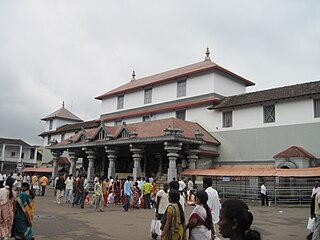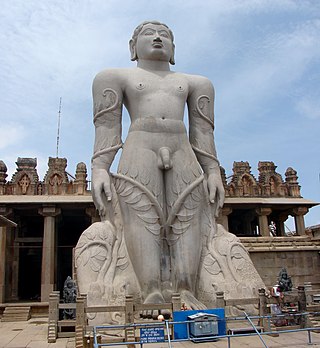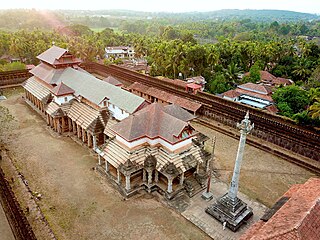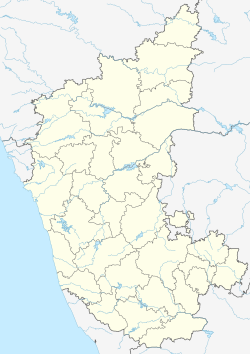
Shravanabelagola is a town located near Channarayapatna of Hassan district in the Indian state of Karnataka and is 144 km (89 mi) from Bengaluru. The Gommateshwara Bahubali statue at Shravanabelagola is one of the most important tirthas in Jainism, one that reached a peak in architectural and sculptural activity under the patronage of Western Ganga dynasty of Talakad. Chandragupta Maurya is said to have died on the hill of Chandragiri, which is located in Shravanabelagola, in 298 BCE after he became a Jain monk and assumed an ascetic life style.

The Māhāmastakābhiṣeka refers to the abhiṣeka (anointment) of the Jain idols when held on a large scale. The most famous of such consecrations is the anointment of the Bahubali Gommateshwara statue located at Shravanabelagola in Karnataka, India. It is an important Jain festival held once every 12 years. It is an integral part of the ancient and composite Jain tradition.

Dharmasthala is an Indian temple town on the banks of the Nethravathi River in the taluk of Belthangady of the Dakshina Kannada district in Karnataka, India.

Dharmasthala Ratnavarma Heggade was an Indian philanthropist, educationist and legislator who is best known for being the hereditary administrator (Dharmadhikari) of the Dharmasthala Manjunatha Temple from 1955 to 1968.

Kumbhoj is the name of an ancient town located in Kolhapur district in Maharashtra. The town is about eight kilometers from Hatkanangale, about twenty seven kilometers from Kolhapur and currently, also is the Taluka or Tehsil Headquarters. The famous Jain Tirtha known as Bahubali, is just two kilometers away from the Kumbhoj city.

Bahubali was the son of Rishabhanatha and the brother of the chakravartin Bharata. He is a revered figure in Jainism. He is said to have meditated motionless for 12 years in a standing posture (kayotsarga), with climbing plants having grown around his legs. After his 12 years of meditation, he is said to have attained omniscience.
The Jain Bunt are the Jains of Bunt caste from Tulunaad area of India. They have a feudal and martial race heritages, because of ties to the erstwhile royalty of the area. They are classified as Other Backward Class (OBC) by the Government of Karnataka.

Moodubidire is a town and taluk in Dakshina Kannada district. It lies 34 km northeast of the district headquarters, Mangalore, in Karnataka, India.
A manastambha is a pillar that is often constructed in front of Jain temples or large Jain statues. In North India, they are topped by four Tirthankara images.

Karnataka, a state in South India has a long association with Jainism, a religion which enjoyed patronage of major historic kingdoms in the state such as the Rastrakuta Dynasty, Western Ganga, Kadamba and Chalukya dynasties and the Hoysala Empire. Today the state is home to a number of Jain monuments, such as temples, Gommata statues and stambhas.
Aladangady or Aladangadi is a small town in the Belthangady taluk of the Dakhina Kannada district in Karnataka, India located on the road connecting Guruvayanakere and Karkala.

Saavira Kambada Temple or Tribhuvana Tilaka Cūḍāmaṇi), is a basadi or Jain temple noted for its 1000 pillars in Moodabidri, Karnataka, India. The temple is also known as "Chandranatha Temple" since it honours the tirthankara Chandraprabha, whose eight-foot idol is worshipped in the shrine.

Karkala is a town and the headquarters of eponymous Karkala taluk in the Udupi district of Karnataka state in India. It lies near the foothills of the Western Ghats, Karkala has a number of natural and historical landmarks, and is a major tourist and transit destination due to its strategic location along the way to Hebri, Sringeri, Kalasa, Horanadu, Udupi, Kollur, Subrahmanya and Dharmasthala.

The Gommateshwara statue is a 57-foot (17 m) high monolithic statue on Vindhyagiri, also known as Indra-giri in the town of Shravanbelagola in the Indian state of Karnataka. Carved of a single block of granite, it is one of the tallest monolithic statues in the ancient world.

Chaturmukha Basadi is a symmetrical Jain temple situated in Karkala, Karnataka, India. It is one of the most famous monuments in Karkala.

The city of Mangalore is proclaimed as the gateway to Karnataka and lies nestled between the blue waters of the Arabian Sea and the green, towering hills of the Western Ghats. The 184 square km city is spread out over the backwaters of the two rivers, Netravati and Gurpura.

Jain hoysala complex in Halebidu, Hassan district consists of three Jain Basadis dedicated to the Jain Tirthankars Parshvanatha, Shantinatha and Adinatha. The complex is situated near Kedareshwara temple and Dwarasamudra lake. The temple complex also includes a step well called Hulikere Kalyani.

Santara or Bhairarasa was a medieval ruling dynasty of Karnataka, India. The area covered by their kingdom included territories in the Malenadu region as well as the coastal districts of Karnataka. Their kingdom had two capitals. Karkala in the coastal plains and Kalasa in the Western ghats. Hence the territory they ruled was also known as the Kalasa-Karkala kingdom. The Santaras were Jains and had matrimonial relations with the Saivite Alupa royal family. The Santaras became the feudatories of the Vijayanagara Empire after its rise. During this period, the Santara ruler Veera Pandya Bhairarasa erected the monolith of Bahubali in Karkala. The dynasty passed into oblivion after invasions by the Nayakas of Keladi and later by Hyder Ali.

Gommateshwara statue, Karkala is located at Karkala in the Indian state of Karnataka. It is the second tallest statue of Bahubali in the world with the largest statue located at Shravanabelagola.















